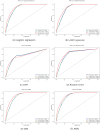A machine learning model for predicting severity-adjusted in-hospital mortality in pneumonia patients
- PMID: 40534897
- PMCID: PMC12174718
- DOI: 10.1177/20552076251351467
A machine learning model for predicting severity-adjusted in-hospital mortality in pneumonia patients
Abstract
Objective: This study aims to develop a customized severity adjustment tool for hospital deaths in pneumonia patients considering characteristics of Korean discharged patients using representative data from the Korea Disease Control and Prevention Agency's Korea National Hospital Discharge In-Depth Injury Survey (KNHDIS).
Methods: We analyzed 46,286 cases of pneumonia hospitalization among KNHDIS data from 2013 to 2022 and developed a model after adjusting for the severity of comorbidities using SAS and Python programs.
Results: Analysis results showed that among three complication adjustment tools, including the existing complication index K-CCI (Korean-Charlson Comorbidity Index) and newly developed m-K-CCI (modified-Korean-Charlson Comorbidity Index) and m-K-CCS (modified-Korean-Clinical Classification Software), m-K-CCS was the best. For model development and evaluation, least absolute shrinkage and selection operator (LASSO), logistic regression, classification and regression tree (CART), random forests, gradient-boosted model (GBM), and artificial neural network (ANN) analyses were performed. Analysis of the validation dataset showed that GBM's m-K-CCS had the highest AUC value of 0.910.
Conclusion: These results suggest that further research is needed on models that adjust for the severity of comorbidities for each diagnosis to more accurately predict health outcomes.
Keywords: Charlson comorbidity index (CCI); Pneumonia; big data; comorbidity; machine learning.
© The Author(s) 2025.
Conflict of interest statement
The authors declared no potential conflicts of interest with respect to the research, authorship, and/or publication of this article.
Figures
Similar articles
-
Surveillance for Violent Deaths - National Violent Death Reporting System, 50 States, the District of Columbia, and Puerto Rico, 2022.MMWR Surveill Summ. 2025 Jun 12;74(5):1-42. doi: 10.15585/mmwr.ss7405a1. MMWR Surveill Summ. 2025. PMID: 40493548 Free PMC article.
-
Predictive modeling the probability of suffering from metabolic syndrome using machine learning: A population-based study.Heliyon. 2022 Dec 10;8(12):e12343. doi: 10.1016/j.heliyon.2022.e12343. eCollection 2022 Dec. Heliyon. 2022. Retraction in: Heliyon. 2025 Mar 25;11(9):e43252. doi: 10.1016/j.heliyon.2025.e43252. PMID: 36643319 Free PMC article. Retracted.
-
Molecular feature-based classification of retroperitoneal liposarcoma: a prospective cohort study.Elife. 2025 May 23;14:RP100887. doi: 10.7554/eLife.100887. Elife. 2025. PMID: 40407808 Free PMC article.
-
Defining disease severity in atopic dermatitis and psoriasis for the application to biomarker research: an interdisciplinary perspective.Br J Dermatol. 2024 Jun 20;191(1):14-23. doi: 10.1093/bjd/ljae080. Br J Dermatol. 2024. PMID: 38419411 Free PMC article. Review.
-
Prevalence and odds of anxiety and depression in cutaneous malignant melanoma: a proportional meta-analysis and regression.Br J Dermatol. 2024 Jun 20;191(1):24-35. doi: 10.1093/bjd/ljae011. Br J Dermatol. 2024. PMID: 38197404
References
-
- Information CI for H. HSMR: a new approach for measuring hospital mortality trends in Canada. Canadian Institute for Health Information, 2007.
-
- Kim K-H, Ahn L-S. A comparative study on comorbidity measurements with lookback period using health insurance database: focused on patients who underwent percutaneous coronary intervention. J Prev Med Pub Health 2009; 42: 267–273. - PubMed
-
- Kim KH. Comorbidity adjustment in health insurance claim database. Health Policy and Management 2016; 26: 71–78.
-
- Charlson ME, Carrozzino D, Guidi J, et al. Charlson comorbidity index: a critical review of clinimetric properties. Psychother Psychosom 2022; 91: 8–35. - PubMed
LinkOut - more resources
Full Text Sources



